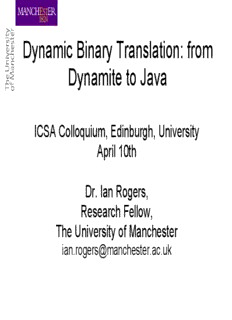
Highly Parallel, Object-Oriented Computer Architecture (also the PDF
Preview Highly Parallel, Object-Oriented Computer Architecture (also the
Dynamic Binary Translation: from Dynamite to Java ICSA Colloquium, Edinburgh, University April 10th Dr. Ian Rogers, Research Fellow, The University of Manchester ian.rogers@manchester.ac.uk Presentation Outline A brief history of binary translation The Dynamite project - A look inside the compiler A fresh approach (Java with everything) Some tales of sorrow A Brief History of Binary Translation Late 1960s and 1970s assembler to assembler translators and microprogramming in the interest of not having to rewrite code and for fast simulation 1980s, financial incentive to run other architectures machine code recognized: - 1987 HP Object Code Translator – MPE V binaries to PA-RISC MPE XL - 1988 AT&T Flashport, static translation of many architectures (e.g. 680X0, IBM 360, PDP11) to many (e.g. PowerPC, SPARC, PA-RISC, IA32) A Brief History of Binary Translation (continued) Early 1990s continued to recognize cost saving in translating rather than porting using static translation: - Accelerator - TNS CISC to TNS/R - VEST & TIE – VAX VMS to Alpha VMS - mx & mxr – MIPS to Alpha Runtime environments emerging to interpret in the cases where translations weren't present: - Mae – Mac emulator for - Executor & Syn68k A Brief History of Binary Translation (continued 2) Mid-1990s saw dynamic binary translation emerging to speed up slow interpreters in runtime environments: - SoftWindows, RealPC – run Windows on Mac - FX!32 – run x86 Windows NT binaries on Alpha Windows NT - DAISY – PowerPC to VLIW PowerPC - Wabi – IA32 Windows to SPARC A Brief History of Binary Translation (continued 3) The emergence of open source: - Bochs - Wine - QEMU - PearPC 2000s, the emergence of virtualization companies - VMWare - Transmeta - Transitive Technologie s A Brief History of Binary Translation (continued 4) Mid-2000s - Rosetta shipped with Apple Intel Macs, Lx86 shipped with IBM PowerVM - Virtualization a hot-topic - QEMU becomes integrated with the Linux kernel, QEMU drivers used to virtualize and migrate Linux - VMWare floats - Interest in binary translation as part of a bigger platform PearColator, VEELS, JPC – leverage Java CLR and LLVM related projects too A Brief History of Binary Translation (continued 5) In parallel binary translators became an important tool in simulation: - atom/shade Security analysis of compiled software - Valgrind Instrumentation and profiling - Dynamo RIO Dynamite Research project started in 1995 - Inspired by the use of Shade for cache simulations - Cristina Cifuentes (UQBT and UQDBT) visited Manchester 1995 Aim to create framework for dynamic binary translation Caught up in dot-com boom, Transitive launched in 2000 Dynamite - backend Originally used Dawson Engler's vcode - Emit statements like RISC code - Porting means implementing emit statements for new architecture Dynamite tcode backend designed to handle x86 as a host architecture
Description: